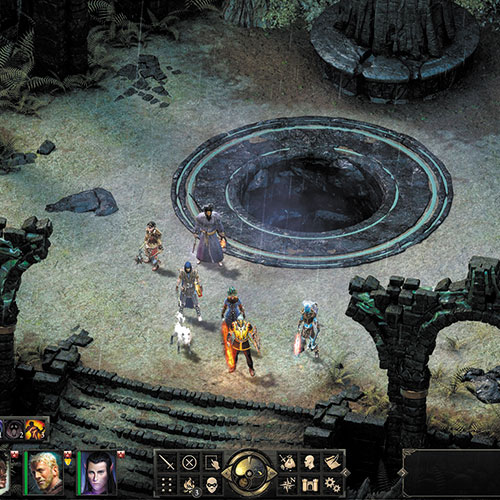Engaging, challenging ‘Pillars’ returns to the glory days

By Matt Miller | Game Informer Magazine
“Pillars of Eternity”
Platform: PC
Style: 1-Player Role-Playing
Publisher: Paradox Interactive
Developer: Obsidian Entertainment
ESRB: M, for Mature
Making a game broadly accessible and appealing often results in something easy and simplistic. “Pillars of Eternity” is proof that role-playing games can be engaging and challenging no matter the player, and embrace complexity in storytelling and gameplay without sacrificing a wider audience. Obsidian’s crowd-funded return to the RPGs of yesteryear is a triumph; its rich cast of characters, myriad upgrade options, and story-filled quests are the equal of any modern genre entry, and a suitable successor to the games that engendered it.
The world of Eora is inspired by the “Dungeons & Dragons” settings, but has enough twists and turns to feel distinct and memorable. Souls regenerate on an endless wheel of reincarnation, slowly eroding with the passage of generations. Some individuals can read these souls, and others manipulate them, but when children begin to be born without souls, trouble is afoot. Awakened to an ancient but forgotten connection to the situation, your personalized hero sets out to uncover the truth.
Storytelling is the paramount concern. Central party members are unusual variations on established archetypes, from an Inuit-inspired dwarven ranger to a wizard with multiple personalities. Books and journals illustrate a painstaking attention to detail for the world’s lore. Lengthy conversations and observations read almost like a visual novel, painting a picture with words that will leave text-skippers missing out on the bulk of the nuance. Even if some sections are overwritten or slow, the writing itself is imaginative.
The rules are elegant and flexible. Rooted in D&D-style mechanics, “Pillars of Eternity” nonetheless recognizes opportunities for improvements in the digital space. Learning the intricacies of all the abilities, spells, defenses, magic items, and classes would be a colossal task, but a smooth learning curve assures that progress never feels overwhelming. Class staples like the rogue and paladin are joined by innovations like the soul-channeling cipher or musical chanter, and every class has some fun tricks. Whether you create an entire party of your own or slowly acquire the preset companions, leveling is a joy; meaningful choices between dozens of spells and ability options provide the sense of a truly customized party. An upgradeable stronghold provides further opportunities for growth. Investment earns new shopkeepers, a prison to hold your enemies, and even new bounty quests to attempt.
Combat is equally customizable, with numerous difficulty settings and options to cater the pause-and-play action to your preferences. Character pathing has always been a problem in top-down isometric RPGs, and sadly that issue is not resolved here; individual movements often require more babysitting than is ideal. However, learning the best use of each party member’s abilities and deploying into the tactically varied battlefields is rewarding. Unlike many recent genre staples, you can’t rely on A.I. to save the day — especially due to the danger of friendly fire. Constant, careful control of every party member is essential.
The wilderness locations, dungeons, and towns are a testament to carefully crafted environments. They are filled with region-specific art, interesting puzzles and traps, and surprising encounters. Experience points are primarily earned through quest completion and location discovery, encouraging players to chart non-combat solutions in many situations. You have a lot of content to explore, from large cities to a massive optional dungeon containing a tantalizing mystery.
The main arc that runs through these numerous locations is intriguing, but the term “side quests” doesn’t do justice to the overwhelming depth and number of additional adventures available. Whether steering towards the larger plot threatening the land or exploring an abandoned lighthouse on the edge of town, quests play off your expectations and often demand difficult choices. The mature topics and themes at play include issues of religious ecstasy, incest, and torture. By taking off the kid gloves, “Pillars of Eternity” elevates the stakes of its own plot, leading up to some weighty choices at the conclusion.
Obsidian has put together a massive game, and exploring both the critical path and a significant chunk of the side content is more than a 50-hour project. With an adventure that big, standard combat encounters can fall into a routine, and the plentiful reading involved may not be for everyone. However, players who have been waiting for a deep, true role-playing epic are virtually guaranteed to fall in love. Obsidian should have no shortage of fans cheering for another installment, and I’ll be among them.











